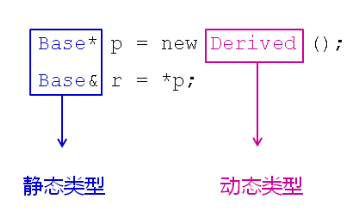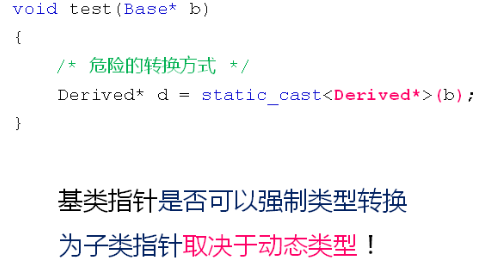第六十六课、c++中的类型识别
2017-02-09 22:14
225 查看
一、类型识别
1、在面向对象中可能出现下面的问题
(1)、基类指针指向子类对象
(2)、基类引用成为子类对象的别名

A、静态类型: 变量(对象)自身的类型(期望的、确定的类型)
B、动态类型: 指针(引用)所指向实际对象的类型


2、解决方案
(1)、在类中定义虚函数返回具体类型的信息
(2)、所有的派生类都必须实现类型相关的虚函数
(3)、每个类中的虚函数都需要不同的实现
3、多态解决方案的缺陷
(1)、必须从基类开始提供类型虚函数
(2)、所有的派生类都必须重写类型虚函数
(3)、每个派生类的类型名必须不唯一
(1)、typeid关键字返回对应参数的类型信息
(2)、typeid返回一个type_info类对象
(3)、当typeid的参数为NULL时将抛出异常
(4)typeid关键字的使用

2、typeid的注意事项
(1)、typeid关键字在不同编译器下对类型名的处理可能不同
(2)、当参数为类型时(如int),返回静态类型信息
(3)、当参数为变量时(如 i)
A、不存在虚函数表:返回静态类型信息
B、存在虚函数表:返回动态类型信息
(2)、利用多态能够实现对象的动态类型识别
(3)、typeid是专用于类型识别的关键字
(4)、typeid能够返回对象的动态类型信息
1、在面向对象中可能出现下面的问题
(1)、基类指针指向子类对象
(2)、基类引用成为子类对象的别名

A、静态类型: 变量(对象)自身的类型(期望的、确定的类型)
B、动态类型: 指针(引用)所指向实际对象的类型


2、解决方案
(1)、在类中定义虚函数返回具体类型的信息
(2)、所有的派生类都必须实现类型相关的虚函数
(3)、每个类中的虚函数都需要不同的实现
#include <iostream>
#include <string>
using namespace std;
class Base
{
public:
//在基类中提供个用来判断类型的虚函数
//并且所有的派生类中都必须实现这个函数
virtual string type()
{
return "Base"; //手动返回一个用于识别的标识符
}
};
class Derived : public Base
{
public:
string type()
{
return "Derived";
}
void print()
{
cout << "I'm a Derived." << endl;
}
};
class Child : public Base
{
public:
string type()
{
return "Child";
}
};
void test(Base* b)
{
//危险的转换方式。因为b可能实际类型可能不是Derived的类型
//Derived* d = static_cast<Derived*>(b);
if(b->type() == "Derived")
{
Derived* d = static_cast<Derived*>(b);
d->print();
}
//如果类中没有虚函数表,则调用dynamic_cast会直接报错,编译不过。
//当父、子类没有继承关系时,dynamic_cast返回false,否则会转换后
//实际对象的地址
cout << dynamic_cast<Derived*>(b) << endl;
}
int main()
{
Base b;
Derived d;
Child c;
test(&b); //Base与Base没有继承关系,dynamic_cast返回false
test(&d); //Derived与Base有继承关系,dynamic_cast转换后对象的地址
test(&c); //Child与Derived没有继承关系,返回false
return 0;
}
/*输出结果:
0
I'm a Derived.
0x23feb8
0
*/3、多态解决方案的缺陷
(1)、必须从基类开始提供类型虚函数
(2)、所有的派生类都必须重写类型虚函数
(3)、每个派生类的类型名必须不唯一
二、类型识别关键字
1、c++提供了typeid关键字用于获取类型信息(1)、typeid关键字返回对应参数的类型信息
(2)、typeid返回一个type_info类对象
(3)、当typeid的参数为NULL时将抛出异常
(4)typeid关键字的使用

2、typeid的注意事项
(1)、typeid关键字在不同编译器下对类型名的处理可能不同
(2)、当参数为类型时(如int),返回静态类型信息
(3)、当参数为变量时(如 i)
A、不存在虚函数表:返回静态类型信息
B、存在虚函数表:返回动态类型信息
#include <iostream>
#include <string>
#include <typeinfo> //for typeid
using namespace std;
class Base
{
public:
virtual ~Base(){}
};
class Derived : public Base
{
public:
void print()
{
cout << "I'm a Derived." << endl;
}
};
void test(Base* b)
{
//const type_info& tb = typeid(b); //判断b的类型,Base*或Derived*
const type_info& tb = typeid(*b); //判断对象的类型
cout << tb.name() << endl;
}
int main()
{
int i = 0;
const type_info& tiv = typeid(i); //判断变量的类型
const type_info& tii = typeid(int); //判断类的类型
cout << (tiv == tii) << endl; //相等
Base b;
Derived d;
test(&b);
test(&d);//无虚函数表数打印的类型名一样(因为Test参数为Base,即静态类型为Base),有虚函数表时则不一样
return 0;
}
/*输出结果:
1
4Base //g++下类名前面的数字表示类名的长度
7Derived
*/三、小结
(1)、c++中有动态类型和静态类型的概念(2)、利用多态能够实现对象的动态类型识别
(3)、typeid是专用于类型识别的关键字
(4)、typeid能够返回对象的动态类型信息
相关文章推荐
- C++标准库:<algorithm>next_permutation() HDU - 1027
- [Boolan]第二周学习笔记——rico风
- 关于【error C3646: 未知重写说明符】的若干种可能性
- LCS最长公共子序列S,P
- [Boolan]第一周学习笔记——rico风
- c语言单链表
- c++之五谷杂粮---2
- C++中前置声明介绍
- C++中前置声明介绍
- 2017-2-9get
- valgrind简介以及在ARM上交叉编译运行
- 组合算法
- 华为机试在线训练-牛客网(20)【中级】字符串运用-密码截取
- C语言:传值,传地址
- C语言可变参数列表解析及简单应用
- C++之声明和定义详解
- 第六十五课、c++中的异常处理(下)
- C++ 初始化方式
- C++中利用string库操作的总结
- [effective modern c++][1]理解模板类型推断
